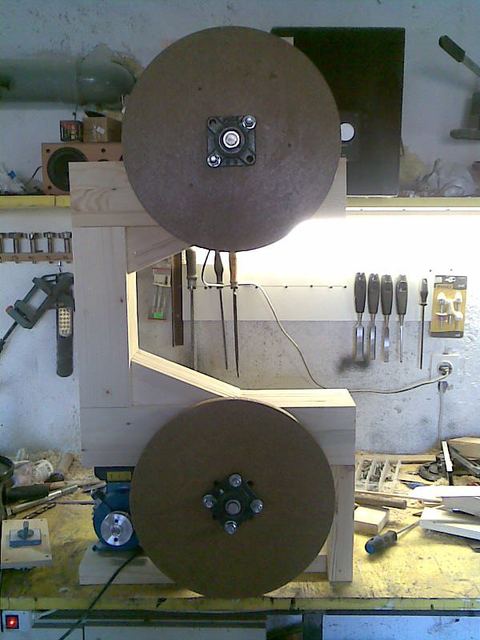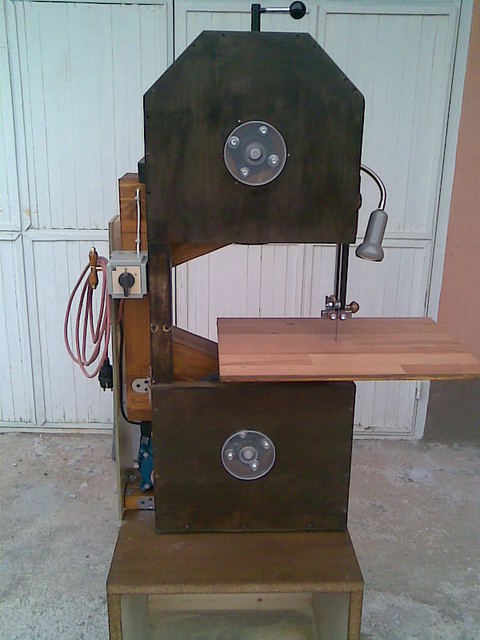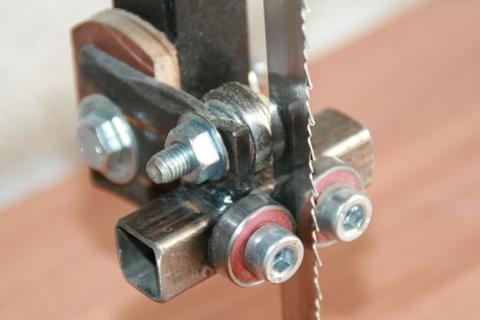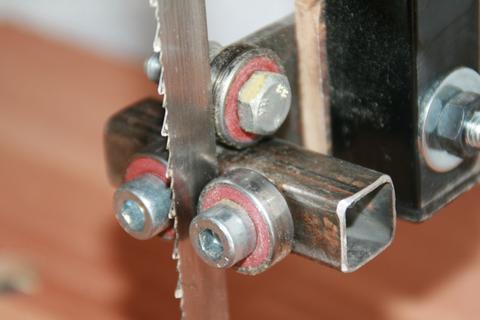

Beri writes:
Hello Matthias,
My name is Berislav Bracun, I'm 39, an electrician, from Croatia. After buying your plans a few months ago, I was finally able to get this project to the end (more or less :) )
Basically, it is your design, but with slight modifications. Not because I think your design is bad, but simply because I used things I had lying around in the garage, or otherwise available.
The most difficult part to acquire was the band saw blade, and believe it or not, 14" inner bicycle tubes. After looking locally, I gave it up and ordered a blade from http://www.tuffsaws.co.uk/ who offered 103.5" blades on eBay. This means I had to shorten the frame (by 0.75") to accommodate the shorter blade. Luckily, I purchased the blade first, and then went on with the project.
The wheels are made from 30 mm particle board, which were used on top of pallets, so the goods don't get damaged. Got those for free, and impregnated them with primer lacquer. The frame is mostly 19mm spruce board off cuts, had to buy just a few small boards to have enough for the frame. The wheels use UNF204 bearings, and a 20 mm steel shaft. Motor came from a water pump, 750W, 1440 rpm.
The large pulley was taken off an old washing machine, and I turned the small one on my old modelers lathe.
Blade guides are made with 6 bearings in total, simply because I have a drawer full of them for servicing electrical motors.
This was a fun project for me, the band saw runs like a charm. I built it mostly for re-sawing boards into thinner stock, since the only two thicknesses I can buy locally are 19 and 27 mm.
Still to do : the tilting table and some sort of fence. Not sure about the
type yet, since my experience with band saws is limited to only this one I
built :)
My comments:
Pretty much everybody makes some changes to the design. It takes somebody fairly skilled to build, and skilled people like to make changes to the design.
With a non-tilting table, it's possible to position the table lower down, so you can get more resaw height out of it than the original design, despite the slightly shorter frame.
Be sure to make sure those bolts are tight. You might have to slightly tighten them with changes in humidity. I had my bearing flanges develop a slight pop every half turn as the wheel was spun slowly, so I knew they were coming loose. But I didn't bolt them as well either. This is why I replaced the metal flanges with wooden ones on my first bandsaw and started with wooden flanges on my second one
Beri responds:
I see that you are worried about the nuts holding the flanges. Don't worry, those are pre-deformed aircraft grade nuts with spring washers under both bolt and nut so that should compensate for changes in thickness in the MDF and can't easily come off. At least not without an impact wrench :)
I asked Beri if he had any closeups of the blade guides:


The blade guides are very simple. I used a short piece of 20x20mm square tubing, drilled four 8 mm holes and filed them out to get 2 slots. This is the part that holds the two bearings supporting the blade from the sides. The part that holds the trust bearing supporting the back side of the blade is a piece of flat 40x60x4mm with the same 2 slots as in the first part. The center slot is used for the bolt that attaches the guides to the vertical column. The second slot is for the bolt that holds the bearing. With 2 slots, the guide is independently adjustable for various blades, and of course, fabrication inaccuracies :)
In my particular case, I used 608 bearings, high speed, rubber sealed (from router motors that normally spin at 30k rpm) M8 bolts with Allen heads, and oversized nuts on which I filed two sides so they go inside the 20mm square tube and not turn with the bolt. The two can be welded together, or even bolted or riveted using an additional L bracket. The only "problem" part are the washers that go in between the bearings and guide. Normal washers are a bit too large, OD should not be larger than the OD of the inner part of the bearing. So I stacked the washers on a 8 mm arbor, tightened them and turned down to size on a small lathe. But, maybe on your side of the world you can walk into a hardware store and get undersized washers for a few coins? Probably yes :)
There was no other reason for making them from these materials other than I had them on hand. You can easily assemble the guides from 2 L brackets and a flat piece for example, not requiring any welding. Attached is a rough sketch made in MSpaint. I tried to take a picture with my phone, but the "objective lens" on that thing can't focus on anything closer than about a meter, so there is no point in sending those. I can borrow a proper DSLR camera and will send a few pictures once I get ahold of it.
I also see a very nice bandsaw from a young countrymen. It is very pleasing to see that at least some young people today can use something that is not a iPhone and do something that is not Facebook or Angry birds. I have been making telescopes as a hobby for many years now, and holding telescope making classes with some other people for youngsters who are interested. Unfortunately, I must say that there is a obvious and dramatic drop in basic crafting skills from an average teenager 15 years ago and now. But, maybe these are not needed anymore. If you know how to program robots, you can probably make anything :)
We corresponded a bit more about the relative economics of making
things yourself and I commented on how that seems to be more alive in
Eastern Europe.
Beri explained:
So here is the situation in Eastern Europe... for example a "Elektra Beckum" bandsaw in similar size like yours cost twice as much as in Germany. Why? Extremely high taxes and import duties needed to "feed" the government and bureaucracy. And on top of that, average salary is less than half than what someone in Germany would make :) So, this explains why people still build their own stuff over here
More about bandsaws
on my woodworking website.
![]()